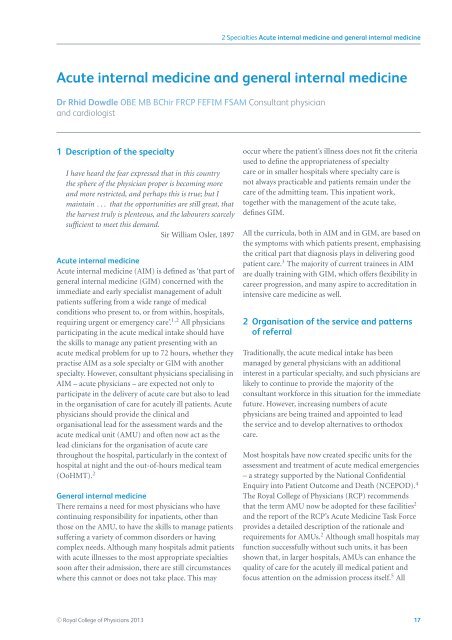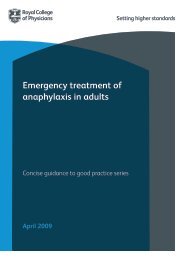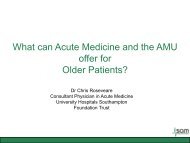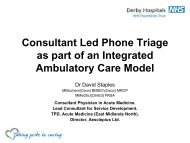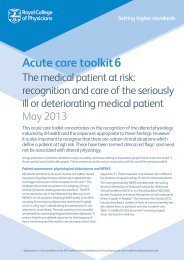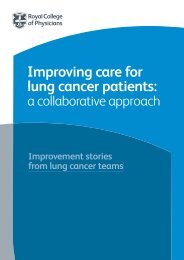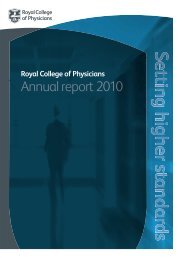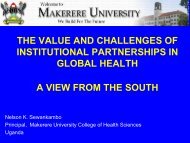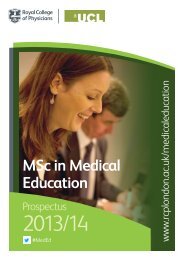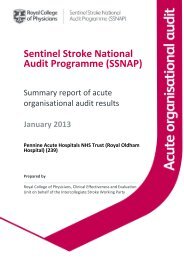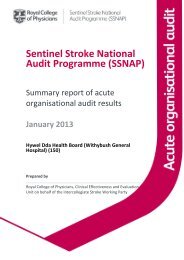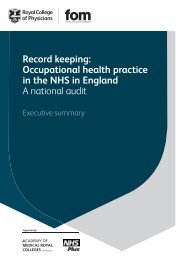Consultant physicians working with patients - Royal College of ...
Consultant physicians working with patients - Royal College of ...
Consultant physicians working with patients - Royal College of ...
Create successful ePaper yourself
Turn your PDF publications into a flip-book with our unique Google optimized e-Paper software.
2 Specialties Acute internal medicine and general internal medicineAcute internal medicine and general internal medicineDr Rhid Dowdle OBE MB BChir FRCP FEFIM FSAM <strong>Consultant</strong> physicianand cardiologist1 Description <strong>of</strong> the specialtyI have heard the fear expressed that in this countrythe sphere <strong>of</strong> the physician proper is becoming moreand more restricted, and perhaps this is true; but Imaintain . . . that the opportunities are still great, thatthe harvest truly is plenteous, and the labourers scarcelysufficient to meet this demand.Sir William Osler, 1897Acute internal medicineAcute internal medicine (AIM) is defined as ‘that part <strong>of</strong>general internal medicine (GIM) concerned <strong>with</strong> theimmediate and early specialist management <strong>of</strong> adult<strong>patients</strong> suffering from a wide range <strong>of</strong> medicalconditions who present to, or from <strong>with</strong>in, hospitals,requiring urgent or emergency care’. 1,2 All <strong>physicians</strong>participating in the acute medical intake should havethe skills to manage any patient presenting <strong>with</strong> anacute medical problem for up to 72 hours, whether theypractise AIM as a sole specialty or GIM <strong>with</strong> anotherspecialty. However, consultant <strong>physicians</strong> specialising inAIM – acute <strong>physicians</strong> – are expected not only toparticipate in the delivery <strong>of</strong> acute care but also to leadin the organisation <strong>of</strong> care for acutely ill <strong>patients</strong>. Acute<strong>physicians</strong> should provide the clinical andorganisational lead for the assessment wards and theacute medical unit (AMU) and <strong>of</strong>ten now act as thelead clinicians for the organisation <strong>of</strong> acute carethroughout the hospital, particularly in the context <strong>of</strong>hospital at night and the out-<strong>of</strong>-hours medical team(OoHMT). 2General internal medicineThere remains a need for most <strong>physicians</strong> who havecontinuing responsibility for in<strong>patients</strong>, other thanthose on the AMU, to have the skills to manage <strong>patients</strong>suffering a variety <strong>of</strong> common disorders or havingcomplex needs. Although many hospitals admit <strong>patients</strong><strong>with</strong> acute illnesses to the most appropriate specialtiessoon after their admission, there are still circumstanceswhere this cannot or does not take place. This mayoccur where the patient’s illness does not fit the criteriaused to define the appropriateness <strong>of</strong> specialtycare or in smaller hospitals where specialty care isnot always practicable and <strong>patients</strong> remain under thecare <strong>of</strong> the admitting team. This inpatient work,together <strong>with</strong> the management <strong>of</strong> the acute take,defines GIM.All the curricula, both in AIM and in GIM, are based onthe symptoms <strong>with</strong> which <strong>patients</strong> present, emphasisingthe critical part that diagnosis plays in delivering goodpatient care. 3 The majority <strong>of</strong> current trainees in AIMare dually training <strong>with</strong> GIM, which <strong>of</strong>fers flexibility incareer progression, and many aspire to accreditation inintensive care medicine as well.2 Organisation <strong>of</strong> the service and patterns<strong>of</strong> referralTraditionally, the acute medical intake has beenmanaged by general <strong>physicians</strong> <strong>with</strong> an additionalinterest in a particular specialty, and such <strong>physicians</strong> arelikely to continue to provide the majority <strong>of</strong> theconsultant workforce in this situation for the immediatefuture. However, increasing numbers <strong>of</strong> acute<strong>physicians</strong> are being trained and appointed to leadthe service and to develop alternatives to orthodoxcare.Most hospitals have now created specific units for theassessment and treatment <strong>of</strong> acute medical emergencies– a strategy supported by the National ConfidentialEnquiry into Patient Outcome and Death (NCEPOD). 4The <strong>Royal</strong> <strong>College</strong> <strong>of</strong> Physicians (RCP) recommendsthat the term AMU now be adopted for these facilities 2and the report <strong>of</strong> the RCP’s Acute Medicine Task Forceprovides a detailed description <strong>of</strong> the rationale andrequirements for AMUs. 2 Although small hospitals mayfunction successfully <strong>with</strong>out such units, it has beenshown that, in larger hospitals, AMUs can enhance thequality <strong>of</strong> care for the acutely ill medical patient andfocus attention on the admission process itself. 5 AllC○ <strong>Royal</strong> <strong>College</strong> <strong>of</strong> Physicians 2013 17


